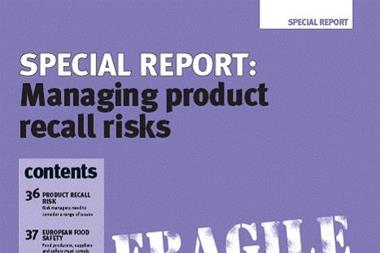Communication can be the difference between a good and badly handled product recall, says Julia Johnson
Communication is the least technical of weapons in a food or beverage company’s product recall armoury. Yet, arguably, it is one of the most powerful. Surprisingly, it is not an area that is overtly covered by the likes of the BRC audit or other industry standards in connection with product recall, but that should not be a reason for any food or drink business to ignore it.
Reputation
If you are in any doubt about the importance of communication, consider first the reputation that your organisation has among its stakeholders. With luck, not to mention a great deal of effort and careful management, your company will have a good reputation. But all that can change quickly if a product recall is mishandled. As Warren Buffett famously said: ‘It takes 20 years to build a reputation and five minutes to ruin it. If you think about that you’ll do things differently.’
In a brand conscious marketplace, it is the damage to a company’s reputation which can result in the most significant costs, well beyond those of actual recall. How you handle a recall most certainly affects your reputation - with customers, suppliers, employees and, if you are a fast moving consumer goods company, with consumers. They will all remember a poorly handled incident. With luck and the right recall management, your stakeholders won’t remember a well handled incident or, if they do, it will be for the right reasons. We can all bring to mind recent examples of badly handled recalls. The better managed events tend not to show up on our radar.
Effective communication is the key difference between the two outcomes.
Communication
Consider for a moment what would happen during a product recall without communication. Different functions within the company would not know what each other were doing, risking duplication of effort or, worse, missed actions. Customers would not find out there was a problem at the same time – if at all. And damaging media coverage could appear without input from the company.
So, let’s agree that communication is essential. But where do you start?
Remember the ‘action, compassion, communication’ triumvirate of managing a product recall, and indeed any other type of crisis situation. First comes action – handling the technical and operational side of the recall and the area that, one would hope, will be a natural response by every product recall team.
The second element in the triangle is compassion. If someone has, or has the potential to, become ill as a result of your product’s problem, it is essential to show compassion. This will probably come naturally to those individuals who are managing the recall, but a corporate filter can come into operation that prevents or distracts many people from displaying their human instincts. Such a filter should be avoided, as far as legal restrictions allow.
Overarching these two steps is communication - ensuring that all the right people know the right information at the right time. Quick responses and regular, accurate updates to customers are essential to convey continuing confidence, with a view to limiting the fallout from negative product reports.
Communication with food regulators, business customers and external specialists like public relations consultants, laboratories, legal and security advisers has to be coordinated and maintained. The starting point should be to list all the company’s stakeholders to ensure no group is overlooked, and then to decide whether they are affected by the recall and, if so, how to communicate with them.
The media will be interested in major recalls, and you should treat media communication as a separate and special case. The media response to a product recall needs to be handled fast and effectively. In these days of 24-hour news and the internet, journalists are working to increasingly tight deadlines. The food sector has experienced a number of well publicised challenges in recent years and some companies have been caught on the back foot at a time when they needed to act fast to reassure the public in response to media reports.
Key messages
It is as well to agree precisely what each stakeholder group will be told – the key messages. Everyone on the team may have an assumption about what the messages are, but it is unlikely these will be precisely the same. And if the detail of the messages is different, confusion could ensue.
If you are dealing with a problem that has the potential to harm consumers the wording of your key messages is even more crucial. It is no exaggeration to say that communicating risk to public audiences can be a fraught business. In the battle between facts and emotions, emotions always win. Communications are often mistakenly based on logic when the emotional aspects of a situation can be much more dominant. This can be extremely difficult for scientists and logical business controllers to factor in, given that they necessarily deal mostly with hard facts.
Logic can falter again when inviting consumers to assess relative risks. Research demonstrates that perceived risk from sensational events (explosions, plane crashes, tower block fires) are vastly overestimated, while more commonplace risks (heart disease, car accidents, slips and falls) are greatly underestimated. Statistical evidence does not persuade the public to hold a different view.
“In the battle between facts and emotions, emotions always win
Work to four golden rules when communicating risk.
Do not mix probability with risk. Probability is not the same as risk. The former does not take account of risk perception - an important consideration. An example of confusing the two is: ‘You are more likely to be struck by lightning than to contract e-coli from product X’. It might be that the probability of being struck by lightning is the same as picking up e-coli from product X, but the phrase won’t reassure the public. Lightning strikes are natural occurrences and outside our control, whereas food safety for product X is within the control of a manufacturer and thus should not fail.
Avoid statistics. Quite apart from the fact that consumers are increasingly sceptical of statistics, which can be manipulated, most people are pretty poor at interpreting risk presented as percentages. Avoid them if at all possible.
Consider frame of reference. The way people perceive risk is linked to their frame of reference. Therefore, formulate key messages in a way that relates to the frame of reference of all your stakeholders. Their knowledge, prejudices and natural predispositions are important indicators of how they will absorb and accept information.
Use a trustworthy source. One of the barriers to overcome in the communication of relative risk is the ‘well, they would say that’ factor. This can be overcome by:
• getting third party endorsement from a credible source (consumer group, charity, university)
• being transparent with the information on which your assessment of risk is based.
Preparation
A hazard analysis critical control point (HACCP) system and traceability process are prerequisites for companies working in the food industry but recall preparation should go much further.
European law requires food products that may be dangerous to health to be removed from sale immediately. It would be almost impossible to comply with this regulation without a well prepared product recall plan in place. Such a document will allow a company to ensure it has the correct procedures set out well ahead of a problem arising and, should a problem occur, assist the company to respond in an appropriate and professional manner. Ultimately a well prepared recall plan will assist a company to protect its brand.
Typically a recall plan will include: details of who is on the recall team and all their contact numbers (including out of hours numbers); deputies for key roles; the roles and responsibilities of each function; a sample incident log; media statement templates that can be adapted as required, and a product recall advertisement template.
The recall plan should be user friendly, not cumbersome and certainly not a document gathering dust on a shelf.
Training
In the weeks since the ditching of the passenger plane on the Hudson River in New York the aviation world has been debating how an ultimately successful outcome was achieved. The consensus appears to be that, although pilots cannot train for every eventuality, they can be and are trained to deal with unexpected incidents under high pressure situations. This training means their brains operate in a different way in pressured situations rather than having to work out how to react from scratch. Exactly the same rationale applies to training for a product recall.
It is important to go beyond the requirements of industry standards, which require companies to run traceability exercises to see how the recall team performs under realistic, pressured conditions. The best way to do this is to run a simulation that tests every aspect of recall readiness. As well as testing individual capabilities within the recall team, and the usability of the recall plan, this also throws light on the team dynamic at work.
Product recalls are common, everyday occurrences within the food industry but familiarity should not breed contempt. Consider for a moment how seriously your business takes communication, whether your recall process is well rehearsed and whether your recall plan is user friendly. If there is any room for improvement in any aspect of them it will be worth a little effort now to reassess them, rather than trying to piece together your company’s reputation later.
The five most common mistakes and how to avoid them
Not having an up-to-date product recall procedure
A fast, effective recall can only be achieved if a robust system is in place. This must be kept up-to-date and should be tested annually to check its validity and to ensure the team knows its responsibilities.
Relying on suppliers' information
Go beyond the 'one up one down' legal requirement to consider your supply chain in full, conducting your own risk assessment of key suppliers and developing strategies to mitigate major risks.
Sticking your head in the sand
Be aware of bubbling issues and new regulatory requirements by monitoring a wide range of technical and industry sources, trade and scientific media and NGOs' outputs. Horizon scanning programmes are easy to establish and can save a lot of grief.
Operating in 'silos'
It is a common occurrence for different functions within an organisation to be aware of risks and issues specific to their function, but for these not to be shared. This 'silo mentality' can mean at best, duplication of effort and, at worst, lead directly to a product recall.
Shying away from the media
Do not be afraid to be proactive with the media. Sometimes engaging with journalists can be the best way to take control of the situation. And there is no substitute for practice, so make sure your spokespeople are media trained.
Postscript
Julia Johnson is senior consultant at Razor, part of the College Hill Group


















No comments yet